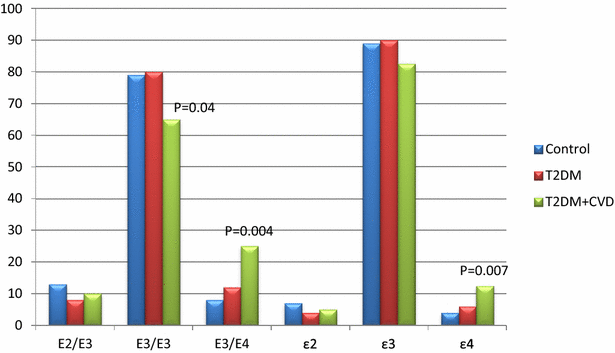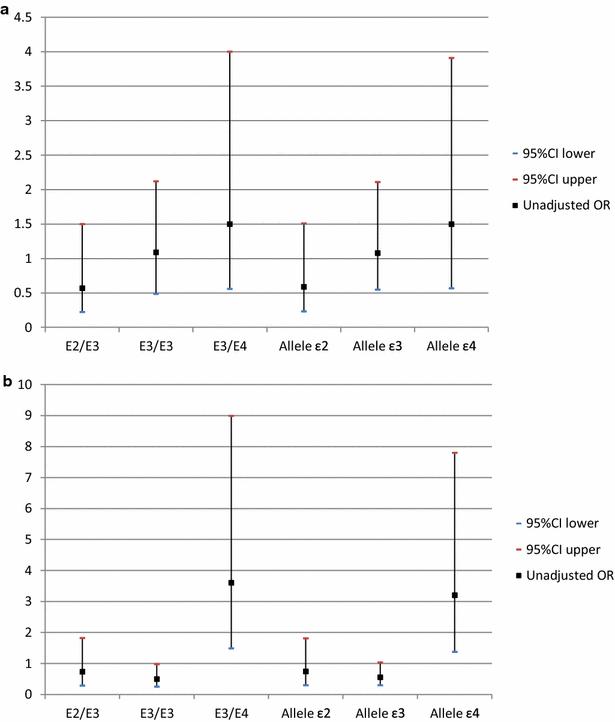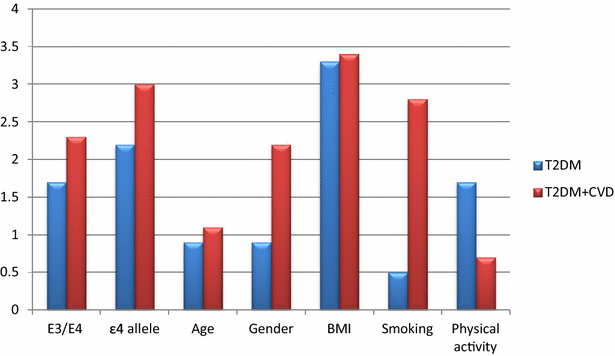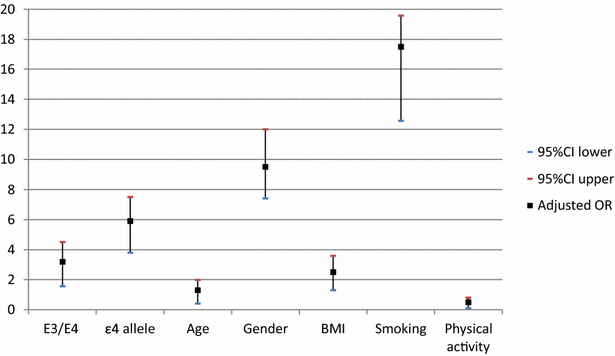Apolipoprotein E gene polymorphism and risk of type 2 diabetes and cardiovascular disease
- PMID: 26800892
- PMCID: PMC4724147
- DOI: 10.1186/s12933-016-0329-1
Apolipoprotein E gene polymorphism and risk of type 2 diabetes and cardiovascular disease
Erratum in
-
Erratum to: Apolipoprotein E gene polymorphism and risk of type 2 diabetes and cardiovascular disease.Cardiovasc Diabetol. 2016 Feb 18;15:35. doi: 10.1186/s12933-016-0354-0. Cardiovasc Diabetol. 2016. PMID: 26892606 Free PMC article. No abstract available.
Abstract
Background: Lipoprotein-related mechanisms have been associated with damage to the cardiovascular system in diabetic patients. Apolipoprotein E gene which affects the clearance of lipoproteins and consequently the lipid profile in our body is one of the most studied candidate genes and recently has been reported to be associated with T2DM and CAD. In this work, we studied the association of apoE gene polymorphism with T2DM and CVD and its effect on plasma lipids profile.
Methods: Our study was conducted on 284 subjects categorized into 100 patients with T2DM, 100 patients with T2DM complicated with CVD and 84 normal control subjects. ApoE gene polymorphism was genotyped by real-time PCR using TaqMan(®) SNP Genotyping Assay.
Results: ApoE E3/E3 genotype was the most common in our subjects. The frequencies of E3/E4 genotype and ε4 allele were increased in both T2DM patients and CVD patients as compared with controls, but were significant only in CVD patients (p = 0.004 and 0.007, respectively). Diabetic patients who carried E3/E4 genotype were at 2.4-fold increased risk to develop CVD (95 % CI 1.14-5.19, P = 0.02) and the ε4 allele associated with 2.23-fold higher CVD risk (95 % CI 1.09-4.59, P = 0.02). After adjustment for other established risk factors, E3/E4 genotype was an independent risk factor for CVD (OR = 2.3, p = 0.009) but not for T2DM (OR = 1.7, p = 0.28), while ε4 allele was an independent risk factor for both T2DM (OR = 2.2, p = 0.04) and CVD (OR = 3.0, p = 0.018) with 5.9-fold increased risk to develop CVD in T2DM patients (p = 0.019). E3/E4 genotype associated with significantly higher levels of TC and non HDL-C in all groups and with significantly higher levels of LDL-C in both T2DM and CVD patients.
Conclusions: ApoE gene polymorphisms associate with CVD and affect the lipid profile. The ε4 allele is an independent risk factor for both T2DM and CVD. Further genetic studies to add information beyond the traditional cardiovascular risk factors in T2DM and to identify risk genotypes will help in early prediction and identification of at risk patients.
Figures





Similar articles
-
Apolipoprotein E gene polymorphism: effects on plasma lipids and risk of type 2 diabetes and coronary artery disease.Cardiovasc Diabetol. 2012 Apr 23;11:36. doi: 10.1186/1475-2840-11-36. Cardiovasc Diabetol. 2012. PMID: 22520940 Free PMC article.
-
Apolipoprotein E gene polymorphism and the risk of cardiovascular disease and type 2 diabetes.BMC Cardiovasc Disord. 2019 Sep 14;19(1):213. doi: 10.1186/s12872-019-1194-0. BMC Cardiovasc Disord. 2019. PMID: 31521122 Free PMC article.
-
Apolipoprotein E E3/E4 genotype is associated with an increased risk of type 2 diabetes mellitus complicated with coronary artery disease.BMC Cardiovasc Disord. 2024 Mar 15;24(1):160. doi: 10.1186/s12872-024-03831-0. BMC Cardiovasc Disord. 2024. PMID: 38491412 Free PMC article.
-
Genetic basis of dyslipidemia in disease precipitation of coronary artery disease (CAD) associated type 2 diabetes mellitus (T2DM).Diabetes Metab Res Rev. 2015 Oct;31(7):663-71. doi: 10.1002/dmrr.2630. Epub 2015 Mar 5. Diabetes Metab Res Rev. 2015. PMID: 25470794 Review.
-
Apolipoprotein status in type 2 diabetes mellitus and its complications (Review).Mol Med Rep. 2017 Dec;16(6):9279-9286. doi: 10.3892/mmr.2017.7831. Epub 2017 Oct 19. Mol Med Rep. 2017. PMID: 29152661 Review.
Cited by
-
Effects of APOE gene ε4 allele on serum lipid profiles and risk of cardiovascular disease and tumorigenesis in southern Chinese population.World J Surg Oncol. 2022 Sep 3;20(1):280. doi: 10.1186/s12957-022-02748-2. World J Surg Oncol. 2022. PMID: 36057714 Free PMC article.
-
Association between APOE genotypes and metabolic syndrome in a middle aged and elderly Urban South Indian population.Metabol Open. 2024 Jul 14;23:100301. doi: 10.1016/j.metop.2024.100301. eCollection 2024 Sep. Metabol Open. 2024. PMID: 39148663 Free PMC article.
-
Central and Peripheral Mechanisms in ApoE4-Driven Diabetic Pathology.Int J Mol Sci. 2020 Feb 14;21(4):1289. doi: 10.3390/ijms21041289. Int J Mol Sci. 2020. PMID: 32075060 Free PMC article.
-
Multiple Mechanisms Linking Type 2 Diabetes and Alzheimer's Disease: Testosterone as a Modifier.J Alzheimers Dis. 2017;59(2):445-466. doi: 10.3233/JAD-161259. J Alzheimers Dis. 2017. PMID: 28655134 Free PMC article. Review.
-
Coronary Heart Disease in Type 2 Diabetes Mellitus: Genetic Factors and Their Mechanisms, Gene-Gene, and Gene-Environment Interactions in the Asian Populations.Int J Environ Res Public Health. 2022 Jan 6;19(2):647. doi: 10.3390/ijerph19020647. Int J Environ Res Public Health. 2022. PMID: 35055468 Free PMC article. Review.
References
-
- International Diabetes Federation (IDF). Diabetes Atlas, 2nd edn. Brussels: International Diabetes Federation. 2003.
-
- International Diabetes Federation (IDF). Diabetes Atlas, 5th edn. Brussels: International Diabetes Federation. 2013, update.
-
- http://www.idf.org/webdata/docs/background_cairo.pdf. Accessed 15 Sep 2015.
Publication types
MeSH terms
Substances
LinkOut - more resources
Full Text Sources
Other Literature Sources
Medical
Miscellaneous

